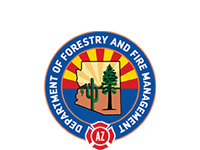2018 Wildfire Activity Stays Low Despite Bleak Outlook
Phoenix, AZ (1/24/19) – Arizona’s 2018 wildfire season started with an unfavorable forecast. The lack of moisture and severe drought conditions set the stage for what could possibly be a very active fire season across the state.
But proactive measures taken by the state and federal partners helped prevent a possibly disastrous season.
And the 2018 end of year wildfire data reflects just that.
According to the Arizona Department of Forestry and Fire Management’s Interagency Dispatch Center, last year, Arizona had 2,000 fires on private, state, federal, and tribal lands.
In 2017, 2,205 wildfires were called into the dispatch center.
Of those 2018 fires, 68% of them were started by humans. That number dropped slightly from the previous year with 72% of Arizona’s fires determined to be human-caused.
But the number of acres burned throughout the state is what had the most significant decrease.
In 2018, more than 165,000 acres burned across Arizona, as compared to the previous year, where fires charred nearly 420,000 acres.
DFFM credits the 2018 decrease to a myriad of factors, including earlier implementation of fire restrictions, as well as closures on both state and federal lands. This is the first time in roughly ten years the state put closures into place for recreational use on state-owned and managed lands.
Other crediting factors include, increased prevention efforts through elevated social media and marketing campaigns, the public’s assistance with restrictions and closures, increased coordination and collaboration between federal, state and local cooperators, prepositioning of crews in higher risk areas, and DFFM’s proactive approach to hazardous fuels reduction work on private and state lands.
“Shortly after our fire activity died down last summer, we jumped right back into project work to eliminate hazardous fuels around the state. We also increased our prescribed burning projects, and have so far burned nearly 6,000 acres of debris piles. Fuels mitigation remains our top priority over the next few months leading up to the time of year we start to see heightened fire activity,” said State Fire Management Officer John Truett.
For more information, contact Tiffany Davila at 602-540-1036 or by email at [email protected]




